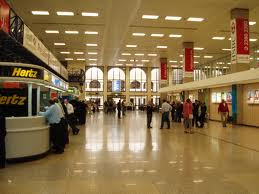Until 1800 Malta depended on cotton, tobacco and its shipyards for exports. After the British arrived, they came to depend on the dockyard for support of the Royal Navy, especially during the Crimean War of 1854. The military base benefited craftsmen and all those who served the military.
In 1869 the opening of the Suez Canal gave Malta's economy a great boost, as there was a massive increase in the shipping which entered the port. Ships stopping at Malta's docks for refuelling helped the Entrepôt trade, which brought additional benefits to the island.
However, towards the end of the 19th century the economy began declining, and by the 1940s Malta's economy was in serious crisis. One factor was the longer range of newer merchant ships that required less frequent refuelling stops.
The dolphin show at Mediterraneo Marine Park. Tourism generates a significant part of the GDP of Malta
Currently, Malta’s major resources are limestone, a favourable geographic location and a productive labour force. Malta produces only about 20% of its food needs, has limited freshwater supplies and has no domestic energy sources. The economy is dependent on foreign trade (serving as a freight trans-shipment point), manufacturing (especially electronics and textiles) and tourism. Malta is a popular tourist destination, with 1.2 million tourists every year.Three times more tourists visit than there are residents. Tourism infrastructure has increased dramatically over the years and a number of good-quality hotels are present on the island, although overdevelopment and the destruction of traditional housing is of growing concern. An increasing number of Maltese now travel abroad on holiday. Although they are still a net importer of tourism, the ratio of inbound tourists to outbound tourists is decreasing.
Film production is a growing contributor to the Maltese economy, with several big-budget foreign films shooting in Malta each year. The country has increased the exports of many other types of services such as banking and finance.
Malta is part of a monetary union, the Eurozone (dark blue).
The government is investing heavily in education, including college.
Malta has recently privatised some state-controlled firms and liberalised markets in order to prepare for membership in the European Union, which it joined on 1 May 2004. For example, the government announced on 8 January 2007 that it is selling its 40% stake in Maltapost, in order to complete a privatisation process which has been ongoing for the past five years.
Malta and Tunisia are currently discussing the commercial exploitation of the continental shelf between their countries, particularly for petroleum exploration.
Malta does not have a property tax.
According to Eurostat data, Maltese PPS GDP per capita stood at 76 per cent of the EU average in 2008.
Banking
The two largest banks in the country are Bank of Valletta and HSBC Bank Malta, both of which can trace their origins back to the 19th Century, making them the earliest established banks in the country. Malta is also home to an international financial centre with several foreign offshore banks.
The Central Bank of Malta (Bank Ċentrali ta' Malta), has two key areas of responsibility: the formulation and implementation of monetary policy and the promotion of a sound and efficient financial system. It was established by the Central Bank of Malta Act on 17 April 1968. The Maltese government entered ERM II on 4 May 2005, and adopted the euro as the country's currency on 1 January 2008.


